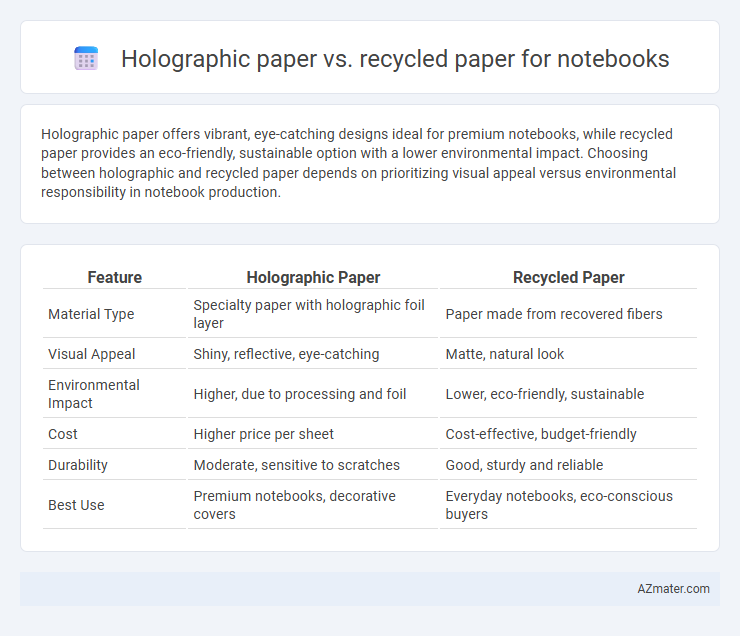Holographic paper offers vibrant, eye-catching designs ideal for premium notebooks, while recycled paper provides an eco-friendly, sustainable option with a lower environmental impact. Choosing between holographic and recycled paper depends on prioritizing visual appeal versus environmental responsibility in notebook production.
Table of Comparison
| Feature | Holographic Paper | Recycled Paper |
|---|---|---|
| Material Type | Specialty paper with holographic foil layer | Paper made from recovered fibers |
| Visual Appeal | Shiny, reflective, eye-catching | Matte, natural look |
| Environmental Impact | Higher, due to processing and foil | Lower, eco-friendly, sustainable |
| Cost | Higher price per sheet | Cost-effective, budget-friendly |
| Durability | Moderate, sensitive to scratches | Good, sturdy and reliable |
| Best Use | Premium notebooks, decorative covers | Everyday notebooks, eco-conscious buyers |
Introduction to Holographic Paper and Recycled Paper
Holographic paper features a reflective, iridescent surface created by micro-embossed patterns that diffract light, making it ideal for visually striking notebook covers and decorative purposes. Recycled paper is produced from recovered materials like post-consumer waste, reducing environmental impact by conserving resources and lowering greenhouse gas emissions during manufacturing. Both paper types cater to different consumer preferences: holographic paper emphasizes aesthetic appeal and uniqueness, while recycled paper prioritizes sustainability and eco-friendliness.
Material Composition: Holographic vs Recycled Paper
Holographic paper consists of a polymer base with embedded diffraction patterns that produce a reflective, shimmering effect, often coated with a thin layer of metalized film for added shine. Recycled paper is made primarily from post-consumer waste fibers, processed to remove dyes and inks, resulting in a more fibrous texture and reduced environmental impact. The structural differences significantly affect durability, surface finish, and environmental sustainability in notebook production.
Environmental Impact Comparison
Holographic paper for notebooks typically involves metallic and plastic coatings that hinder biodegradability and recycling, leading to increased environmental pollution and landfill waste. Recycled paper, manufactured from post-consumer waste, significantly reduces deforestation, energy consumption, and water usage compared to virgin paper production, contributing to a lower carbon footprint. Choosing recycled paper notebooks supports sustainable resource management and waste reduction, whereas holographic paper poses greater ecological challenges due to its complex material composition.
Visual Appeal and Aesthetic Differences
Holographic paper offers a striking, reflective surface that changes colors and patterns with light angles, making notebooks visually dynamic and eye-catching. Recycled paper features a matte, natural texture with organic fibers, providing an earthy, minimalist aesthetic that appeals to eco-conscious consumers. The choice between holographic and recycled paper significantly impacts a notebook's visual identity, balancing bold, futuristic designs against sustainable, understated elegance.
Printing and Writing Quality
Holographic paper offers vibrant, eye-catching visuals with reflective surfaces that enhance printed designs but can cause challenges in ink adhesion and drying time, potentially leading to smudging or uneven writing. Recycled paper provides a more matte, consistent texture that facilitates smoother pen and pencil application, ensuring clearer and more reliable writing quality. For high-quality printing and everyday writing, recycled paper is preferred for its balanced performance and eco-friendly attributes.
Durability and Practicality
Holographic paper for notebooks offers exceptional durability due to its laminated surface, which resists tearing, moisture, and wear, making it ideal for long-term use. Recycled paper, while environmentally friendly and practical for everyday writing, generally lacks the same resistance to physical damage and moisture, reducing its longevity under frequent handling. Choosing between the two depends on prioritizing robustness and aesthetic appeal versus sustainability and cost-effectiveness.
Cost Analysis: Holographic vs Recycled Notebooks
Holographic paper notebooks typically incur higher production costs due to specialized materials and complex manufacturing processes, resulting in a price premium compared to recycled paper notebooks. Recycled paper notebooks offer more cost-effective options by utilizing environmentally friendly, lower-cost raw materials and simpler production techniques. Businesses and consumers often weigh these cost differences alongside sustainability goals and aesthetic preferences when choosing between holographic and recycled paper notebooks.
Consumer Preferences and Market Trends
Consumers increasingly favor recycled paper for notebooks due to its environmental benefits, aligning with rising eco-conscious trends in stationery markets. Holographic paper appeals to niche segments seeking visually striking designs but generally commands higher prices and lower sustainability ratings. Market data indicates growing demand for recycled paper notebooks driven by green consumerism, while holographic paper remains popular primarily in premium or specialty product lines.
Best Uses for Each Paper Type
Holographic paper excels in creative projects, gift wrapping, and eye-catching notebook covers due to its reflective, vibrant surface that enhances visual appeal and attracts attention. Recycled paper is ideal for everyday notebook use, environmentally conscious consumers, and bulk printing needs, offering durability and sustainability with reduced environmental impact. Choosing between the two depends on whether the priority is aesthetic appeal or eco-friendly functionality.
Conclusion: Choosing the Right Paper for Your Notebook
Selecting the right paper for your notebook depends on your priorities: holographic paper offers a visually striking, unique look ideal for creative projects or special editions, while recycled paper supports environmental sustainability and cost-effectiveness without sacrificing quality. Holographic paper enhances aesthetic appeal and adds a premium feel, whereas recycled paper aligns with eco-friendly values and reduces carbon footprint. Balancing design impact and environmental responsibility ensures your notebook meets both functional and ethical standards.

Infographic: Holographic paper vs Recycled paper for Notebook
 azmater.com
azmater.com